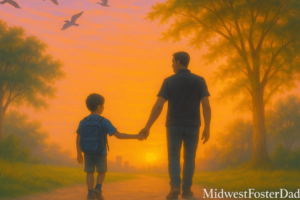Let’s be real. You see your kid glued to a screen, thumbs flying, maybe even yelling at pixels, and a part of you panics. Is this healthy? Are they turning into screen zombies? Am I failing them? If you’ve felt that knot in your stomach watching your kid playing video games, trust me, you’re not alone.
I remember vividly when my son, who came to us through foster care before we adopted him when he was 6, first got into tablet games. The idea of him playing wasn’t frightening in itself – I grew up in what I consider the golden age of gaming. My first console was a Nintendo 64, and my memories aren’t just the games, but who I played with. Those late-night Mario Party battles with my sisters, trying (and failing initially) to beat Zelda: Ocarina of Time with my neighbor – mostly just jumping around using a chicken to fly! (To my credit, I did go back and beat it years later). Those memories were about connection, laughter, and shared adventure.

But with my son, it was different. Having bounced through several foster homes, he’d never really had anything that was truly his. Video games weren’t something he got to play much. So, when he got that tablet, he loved it. It became his world, all he wanted to do day and night. But the joy quickly turned sour. Losing a game? Time to put it away? Cue the meltdowns. Screaming. Throwing the tablet. It was… a lot. What worried me wasn’t the gaming itself, but the behaviors that came with it.
Part of me felt immense empathy. Knowing his history, the trauma, the lack of control he’d experienced, I get why letting go was hard. So, maybe I was a bit too lenient at first. Part of it was my fault honestly. Giving him that free rein, hoping it would help him feel secure, actually kind of backfired. It had consequences. What I was seeing felt like the opposite of my own joyful gaming memories.
Like many parents, I worried about the usual suspects: addiction, violence, and social isolation. The headlines scream about the dangers of video games. But then something shifted. Almost by accident, driven partly by desperation and partly by remembering my own joy, I decided to join him. And what I discovered was that picking up that second controller wasn’t adding to the problem – playing video games with him, together, was opening a door to connection I hadn’t expected.
This isn’t just another article debating screen time. This is about how sharing the gaming experience, especially diving into family co-op games, can be a surprisingly powerful and modern way to build bonds. To spark real communication, develop crucial life skills, and navigate those inevitable parenting challenges. And let me tell you, for families like mine, built through the unique journey of foster care and adoption, it can be an absolute game-changer.
What You’ll Discover in This Post:
- Why gaming together is different than solo screen time
- How controllers can become communication tools (even for tough topics)
- The surprising skills kids learn while playing (strategy, teamwork!)
- Tips for managing screen time limits and frustration (like mine and theirs)
- The unique bonding power of gaming for foster and adoptive families
More Than Pixels: Why Gaming Together Builds Real Bonds
Think about it. When you sit down with your child to play a game, you’re not just passively observing them in their world; you’re actively entering it. You’re sharing an experience, learning their language, seeing what excites them, what frustrates them, and how their mind works. Suddenly, that screen isn’t a barrier between you; it’s a shared space.
For me, that moment came when we moved beyond the solo tablet experience to console games we could play side-by-side. It wasn’t about winning or losing anymore (though, let’s be honest, a little friendly competition is fun!). It was about the shared experience, the teamwork, the common ground we were creating, the inside jokes that started cropping up. We were creating a shared language built on navigating digital worlds together. It’s like finding a secret clubhouse. This shared experience can be incredibly powerful, especially when you’re trying to connect with a child who might have walls up. It bypasses the need for awkward “how was your day?” questions and jumps straight into shared activity and, often, shared laughter.
Remembering my own positive N64 experiences, I realized the magic wasn’t just the game, but the who. Playing with my son started creating those same kinds of positive memory anchors for us. It became less about the game and more about the time spent navigating it as a team. That controller truly became a bridge. Building these connections is central to the foster care journey, and finding common ground is essential. Sometimes, the traditional methods feel forced, but meeting kids in their space, like a digital playground, can make all the difference. If you’re navigating similar challenges, know that creating stability and connection is key.
Level Up Communication: Talking Through the Joysticks

You might think gaming involves mostly grunts and button-mashing, but you’d be surprised how much communication actually happens when you’re gaming together.
First, there’s the practical talk: “Watch out for that creeper!” “Okay, you grab the mushroom, I’ll take the shell.” “We need to find more wood to build the shelter.” This kind of strategic talk and discussion about rules, especially in cooperative video games, requires listening, planning, and expressing ideas clearly.
Then there’s the emotional communication. Gaming provides a surprisingly safe space to talk about frustration, disappointment, and even anger. When my son initially had those huge reactions to losing, playing with him allowed me to be right there in the moment. Instead of just seeing the outburst, I saw the trigger. I could say, “Man, that was frustrating! That blue shell got me too,” validating his feelings before talking about how we handle that frustration. It opened the door to conversations about managing emotions that felt less like a lecture and more like shared troubleshooting.
And sometimes, the most profound conversations happen unexpectedly. Maybe it’s the shared focus, the relaxed atmosphere, or the feeling of being on the same team, but we’ve had moments during a quiet Minecraft building session or after a silly Mario Kart race where deeper topics surface. It’s provoked deep conversations about topics such as past trauma that we’d never been able to have a meaningful conversation about before. Things that might feel too heavy or direct to bring up face-to-face otherwise. The shared activity creates a buffer, making vulnerability feel a bit safer. When you’re focused on building a virtual house together, sometimes the walls around the heart come down a little too. Playing Minecraft with family, for instance, isn’t just about placing blocks; it’s about collaborative creation and the natural conversation flow that happens during that process.
Bonus Points: Skills Beyond the Screen
Okay, so it helps with bonding and communication. But what about those skills parents are always hoping their kids develop? Turns out, playing video games with kids can be a powerful training ground.
Problem-Solving and Strategy (Thinking Caps On!)
Forget flashcards for a second. Many games are essentially complex puzzles wrapped in fun. Think about Minecraft – you need resources, you need shelter, you need to figure out how to craft tools and manage inventory. Or Mario Kart – it’s not just random driving; it’s about learning the tracks, timing your boosts, using items strategically (and sometimes deviously!). When you play together, you’re modeling problem-solving in real-time. You’re thinking out loud, trying different approaches, celebrating successes, and analyzing failures. “Hmm, that didn’t work, maybe we should try building the bridge over here instead?” That’s critical thinking in action. As we’ve played more, I’ve noticed my son has started picking up my tendencies and actively strategizes against me in Mario Kart now – it’s awesome (and slightly terrifying) to see him analyze my moves and plan his own!
Social Skills and Teamwork (No ‘I’ in ‘Team Fortress’)
While solo gaming can be isolating, family co-op games are fantastic for teaching social skills. Sharing resources in Minecraft, taking turns in Mario Party, coordinating attacks in a cooperative adventure game – these all require skills vital for real-world interaction. Kids learn to negotiate (“Okay, you can have the diamond pickaxe this time”), compromise, lead, follow, and handle both winning and losing gracefully (eventually!). It’s a low-stakes environment to practice navigating social dynamics. Seeing my son learn to wait his turn or share a virtual item without prompting? That’s a parenting win, right there. These are absolutely skills that benefit from practice, especially for kids who may have missed early opportunities for social learning due to instability – a common challenge in the world of adoption and foster care.
Cognitive Boost (Brain Training Masquerading as Fun)
Don’t underestimate the brainpower involved! Fast-paced games can improve reaction times and reflexes. Navigating complex 3D environments like those in Zelda or Minecraft enhances spatial reasoning. Managing resources, tracking objectives, remembering complex rules – it all contributes to better memory, attention, and executive function skills. It’s not just mindless entertainment; it’s active engagement that keeps the brain buzzing. The cognitive benefits of gaming are real, and when you’re playing with them, you’re guiding that engagement.
Navigating the “Game Over” Screen (Because Challenges ARE Real)
Alright, let’s not paint an entirely rosy picture. Gaming together isn’t always sunshine and rainbows. There will be arguments over controllers, frustration with difficult levels, and the inevitable struggle of turning the damn thing off. But approaching these challenges together makes a difference.
Setting Healthy Limits (The Not-So-Fun Part)
Unlimited screen time isn’t the goal. Setting video game limits is crucial, just like with any activity. What worked for us was being clear and consistent about when and for how long gaming could happen. Transition warnings are key – nobody likes being ripped away mid-level. Giving a “10 minutes left!” heads-up helps manage expectations and reduces meltdown potential. It’s also about balance – ensuring gaming is only one part of a varied diet of activities. The key is making the limits feel predictable and fair, not arbitrary punishments. Discussing why limits are important (sleep, homework, other fun stuff) can also help older kids buy in.
Managing Frustration (Yours and Theirs)
Remember my son’s tablet-throwing phase? Yeah, frustration is real. Kids (and adults!) get angry when they lose or get stuck. Playing together allows you to model healthy coping mechanisms. Instead of just shutting it down, you can acknowledge the feeling: “Wow, that boss is tough! It’s okay to feel frustrated.” You can talk through strategies, take breaks, or even just share a laugh about how ridiculously hard a certain part is. It turns a moment of potential conflict into a teaching opportunity about resilience and emotional regulation. It’s not about preventing frustration, but about teaching kids how to handle those big feelings when they arise. This is especially important for kids working through past trauma, where emotional regulation can be a significant hurdle.
The Foster/Adoptive Family “Cheat Code”
Everything I’ve talked about – connection, communication, skill-building, navigating challenges – takes on an even deeper meaning for foster and adoptive families. Building trust and attachment, especially with older children who come with established histories and potential trauma, can feel like an uphill battle. You’re trying to build a relationship, sometimes from scratch, while navigating complex emotions and behaviors.
This is where playing video games with kids can feel like a cheat code. It provides a neutral territory, an activity where the power dynamics can shift. You’re not just the authority figure; you’re a teammate, a co-adventurer. It allows for connection without forced intimacy, which can be crucial for kids who are wary or have attachment difficulties. It’s a way to share joy, laughter, and even frustration side-by-side, building shared history moment by moment. Gaming together has had such a huge impact on our bond; it has brought us closer together than we’ve ever been. It’s led to endless amounts of laughter and joy shared.
For foster parents specifically, who can have a very hard time creating those bonds, particularly if the kid comes to you at an older age, it can feel like you’ve missed so much. While you can’t make up that lost time, video games certainly help give a boost to “fill in the holes,” creating new pathways for connection and understanding. It’s a strategy that leverages a universally enjoyed activity. I’ve always loved video games, so seeing him share that same joy and passion is such a great feeling to have as a dad. We all want that activity to bond with our kids over, and I am so lucky (and grateful) to have found that with gaming.
Gaming can be enjoyed by everyone. Whether you’re a kid or an adult. Boy or girl. There’s something for everyone. It’s just a matter of finding the game for you and your family that can serve as a catalyst to developing deeper, stronger bonds. Take Mario Kart – it’s a great example of a game anyone can join in on, even if they have no experience.
Ready to Press Start?
Look, I get the hesitation. The worries about screen time are valid. But maybe, just maybe, that controller isn’t the enemy. Maybe it’s a tool. A bridge. An invitation into your child’s world and a way to invite them into shared experiences with you.
It won’t solve every parenting challenge, and it requires setting boundaries and navigating frustrations just like anything else. But the potential payoff? Deeper connection, easier communication, shared laughter, and maybe even discovering your inner gamer.
So, don’t just see the screen; see the bridge. Pick up that controller. Ask them to show you their world. Press start on connection. You might be surprised by the adventure you share.
Frequently Asked Questions (FAQ)
- Is playing video games with kids actually good for them?
Yes, when done thoughtfully and together! Shared gaming can strengthen family bonds, improve communication (even about tough topics like trauma), and teach valuable skills like problem-solving, strategy, and teamwork, turning screen time into positive interaction. It’s less about the game and more about the shared experience. - What are some good family co-op games to start with?
Games like Minecraft (creative, collaborative building, good for conversation), Mario Kart (fun competition, easy for anyone to learn), Overcooked (chaotic teamwork), or Lego games (puzzle-solving, familiar themes) are often great starting points. Look for games with cooperative modes where you work together. - How can I set video game limits without constant battles?
Consistency and communication are key. Establish clear rules upfront about when and how long gaming happens, involve kids in setting timers (if age-appropriate), and always give transition warnings (like a “10 minutes left!” callout). Explaining the why behind limits also helps. - Can gaming really help me bond with my foster or adopted child?
Absolutely. Gaming provides a low-pressure, shared activity that can build trust and connection, especially with older kids or those with trauma histories who resist direct interaction. Entering their world through play shows you value their interests and creates opportunities for natural communication, shared laughter, and building positive memories, which is vital for attachment. - My child gets really angry when they lose; how can gaming together help?
Playing alongside them allows you to model healthy responses in real-time. Validate their feelings (“Man, that was frustrating! It’s okay to feel angry”), talk through what happened, strategize for next time, and emphasize the fun of playing together over winning, turning losses into resilience-building moments.
What are your favorite games to play with your kids? Share your experiences and any tips you have in the comments below! And if you found this helpful, please share it with other parents who might be wondering if gaming can be more than just a time-filler.
Don’t forget to follow for more insights on parenting, foster care, and finding connection in unexpected places!




